I-Hsiang Chen
The Tenth NTIRE 2025 Efficient Super-Resolution Challenge Report
Apr 14, 2025Abstract:This paper presents a comprehensive review of the NTIRE 2025 Challenge on Single-Image Efficient Super-Resolution (ESR). The challenge aimed to advance the development of deep models that optimize key computational metrics, i.e., runtime, parameters, and FLOPs, while achieving a PSNR of at least 26.90 dB on the $\operatorname{DIV2K\_LSDIR\_valid}$ dataset and 26.99 dB on the $\operatorname{DIV2K\_LSDIR\_test}$ dataset. A robust participation saw \textbf{244} registered entrants, with \textbf{43} teams submitting valid entries. This report meticulously analyzes these methods and results, emphasizing groundbreaking advancements in state-of-the-art single-image ESR techniques. The analysis highlights innovative approaches and establishes benchmarks for future research in the field.
Improving Point-based Crowd Counting and Localization Based on Auxiliary Point Guidance
May 17, 2024Abstract:Crowd counting and localization have become increasingly important in computer vision due to their wide-ranging applications. While point-based strategies have been widely used in crowd counting methods, they face a significant challenge, i.e., the lack of an effective learning strategy to guide the matching process. This deficiency leads to instability in matching point proposals to target points, adversely affecting overall performance. To address this issue, we introduce an effective approach to stabilize the proposal-target matching in point-based methods. We propose Auxiliary Point Guidance (APG) to provide clear and effective guidance for proposal selection and optimization, addressing the core issue of matching uncertainty. Additionally, we develop Implicit Feature Interpolation (IFI) to enable adaptive feature extraction in diverse crowd scenarios, further enhancing the model's robustness and accuracy. Extensive experiments demonstrate the effectiveness of our approach, showing significant improvements in crowd counting and localization performance, particularly under challenging conditions. The source codes and trained models will be made publicly available.
RVSL: Robust Vehicle Similarity Learning in Real Hazy Scenes Based on Semi-supervised Learning
Sep 18, 2022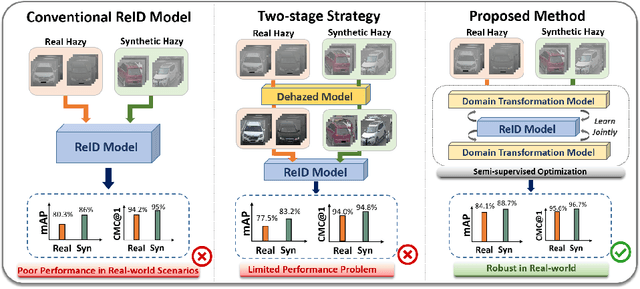

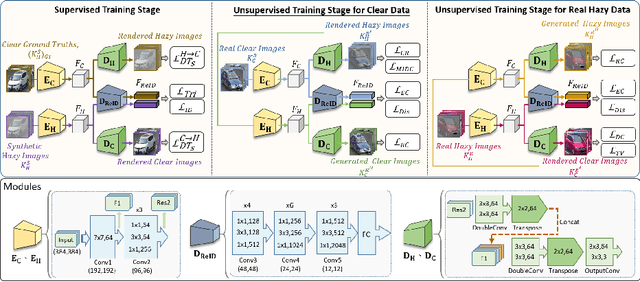
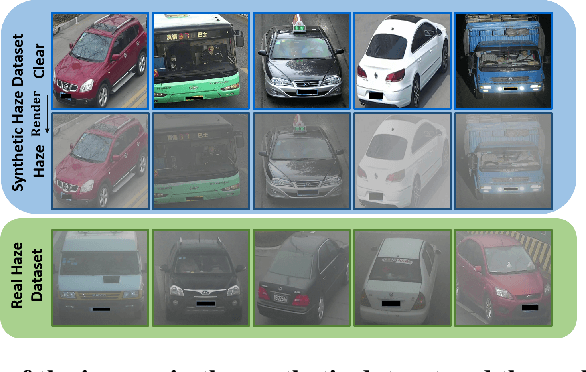
Abstract:Recently, vehicle similarity learning, also called re-identification (ReID), has attracted significant attention in computer vision. Several algorithms have been developed and obtained considerable success. However, most existing methods have unpleasant performance in the hazy scenario due to poor visibility. Though some strategies are possible to resolve this problem, they still have room to be improved due to the limited performance in real-world scenarios and the lack of real-world clear ground truth. Thus, to resolve this problem, inspired by CycleGAN, we construct a training paradigm called \textbf{RVSL} which integrates ReID and domain transformation techniques. The network is trained on semi-supervised fashion and does not require to employ the ID labels and the corresponding clear ground truths to learn hazy vehicle ReID mission in the real-world haze scenes. To further constrain the unsupervised learning process effectively, several losses are developed. Experimental results on synthetic and real-world datasets indicate that the proposed method can achieve state-of-the-art performance on hazy vehicle ReID problems. It is worth mentioning that although the proposed method is trained without real-world label information, it can achieve competitive performance compared to existing supervised methods trained on complete label information.
ContourletNet: A Generalized Rain Removal Architecture Using Multi-Direction Hierarchical Representation
Nov 25, 2021
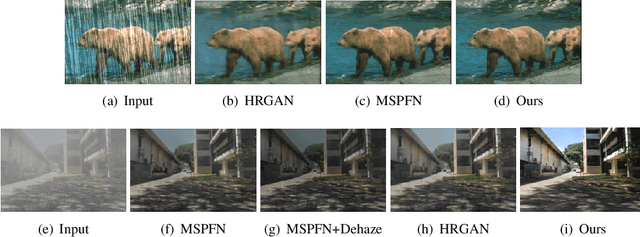

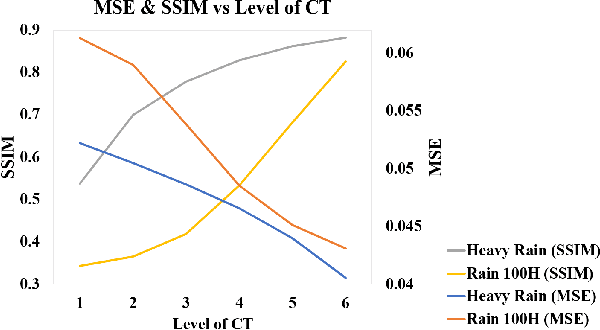
Abstract:Images acquired from rainy scenes usually suffer from bad visibility which may damage the performance of computer vision applications. The rainy scenarios can be categorized into two classes: moderate rain and heavy rain scenes. Moderate rain scene mainly consists of rain streaks while heavy rain scene contains both rain streaks and the veiling effect (similar to haze). Although existing methods have achieved excellent performance on these two cases individually, it still lacks a general architecture to address both heavy rain and moderate rain scenarios effectively. In this paper, we construct a hierarchical multi-direction representation network by using the contourlet transform (CT) to address both moderate rain and heavy rain scenarios. The CT divides the image into the multi-direction subbands (MS) and the semantic subband (SS). First, the rain streak information is retrieved to the MS based on the multi-orientation property of the CT. Second, a hierarchical architecture is proposed to reconstruct the background information including damaged semantic information and the veiling effect in the SS. Last, the multi-level subband discriminator with the feedback error map is proposed. By this module, all subbands can be well optimized. This is the first architecture that can address both of the two scenarios effectively. The code is available in https://github.com/cctakaet/ContourletNet-BMVC2021.
 Add to Chrome
Add to Chrome Add to Firefox
Add to Firefox Add to Edge
Add to Edge